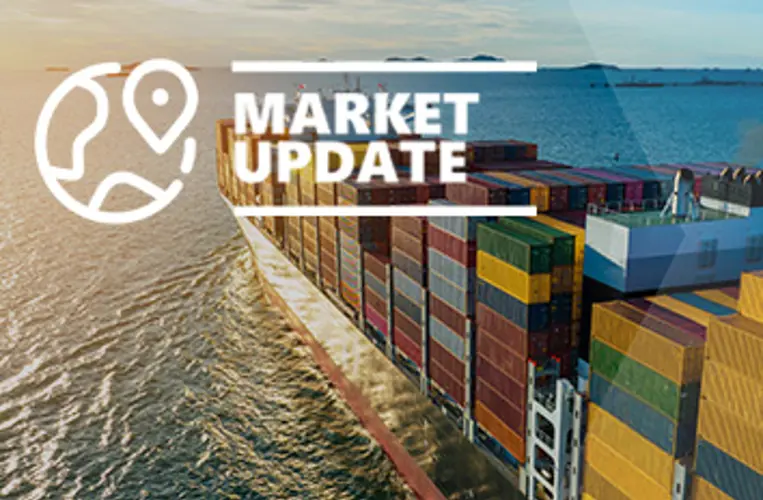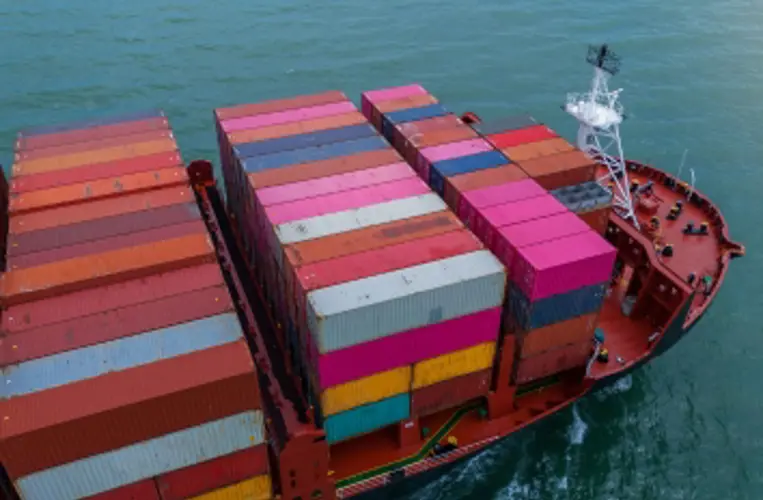On behalf of Scan Global Logistics

Global COO & CCO
Advisory
29 Aug, 2024

Rail strike in Canada, political unrest in Bangladesh, continued attacks in the Red Sea, and uncertainty on a looming port labour strike on the US East Coast are just a few “down-lights” that continue to cause havoc on global supply chains.
Elevated freight rates, both within airfreight and ocean freight, remain a red-hot topic as well. As we have communicated on a few occasions, the historic supply and demand indicators no longer work in the current macro-environment, and it is now the level of volatility and disruption that plots the course for future freight rate development.
We are committed to solving these challenges alongside you, and rest assured there is no one-size-fits-all in our vocabulary when it comes to finding the right solution.
Our general take on the long-term market outlook is that volatility will be a constant force to be navigated and this is across all transport modes.
Enjoy the onwards reading where we will aim to provide you with our take on the general market development, including a deep dive on some of the current major events and trends impacting the industry.
Red Sea situation goes from bad to worse
The security situation in the Red Sea continues to deteriorate due to ongoing attacks by Houthi rebels on commercial vessels.
On 21 August, Houthi Rebels gave the world a stark reminder that the threat of attacks in the Red Sea is as high as ever before. The Iranian-backed Houthi rebels attacked Greek-flagged oil tanker Sounion as part of their 10-month campaign against commercial shipping vessels traversing the Red Sea.
The Sounion was the third vessel operated by Athens-based Delta Tankers to come under Houthi attack during the last month. Houthi spokesman Yahya Saree commented: “It attacked the tanker part because Delta Tankers violated its ban on entry to the ports of occupied Palestine”. Delta Tankers issued a short statement reading, “Delta Tankers is doing everything it can to move the vessel and its cargo. For security reasons, we are not in a position to comment further”.[1]
The Houthis first damaged the tanker on Wednesday, 21 August, in a series of attacks that caused a fire and loss of engine power. A European warship later rescued all 25 crew members. The damaged tanker carrying 150,000 metric tons of crude oil suffered devastating damages due to a series of fires.
The Djibouti Ports & Free Zones Authority said in a post on social media site “X” that “a potential spill could lead to disastrous consequences for the region´s marine environment,” with leading marine experts fearing it could lead to one of the worst ship-source oil spills in history.

Source: CNN
Continued Red Sea crisis has no end in sight, causing headache for the new Gemini alliance
There is little hope that the Red Sea crisis will end in 2024, and consequently, container carriers will continue to utilize Cape of Good Hope routing, which in concrete terms adds 10-14 days in additional transit time in comparison with the Suez Canal passage.
While the current situation seems to have settled into a new normal mode, then the upcoming ocean freight alliance shake-up will be affected, if the current situation continues into 2025.
1 February 2025 marks the start of the new Gemini alliance, comprising Maersk Line and Hapag Lloyd. Additionally, it marks the start date for the Gemini “Hub & Spoke” schedule model, which will largely depend on being able to utilize the Suez Canal passage.
At this point, it is too early to speculate on the specific effects. However, the eagerly anticipated return to +80 % schedule reliability performance seems very far away in general, and this is also the case for the Gemini alliance, which has set itself a schedule reliability target of 90 %.
The Gemini alliance has, on top, been mandated by the Federal Maritime Commission (FMC) in the United States to provide additional documentation in connection with the approval process for the new alliance[2]. This development, combined with the Red Sea situation, could lead to a scenario where the new alliance will kick-off with a different schedule design, compared to what was initially communicated when the alliance was announced.
Generally, industry-wide schedule reliability figures continue to hover around the 55-60 % mark with no immediate signs of improvement.

Source: Global Liner performance
Ocean freight rates reach peak, and downward trajectory mode initiated
In recent weeks, short-term rate levels have been on a downward trajectory following many weeks of increase upon increase, ultimately reaching the “magic” level of USD 10.000 on Far East-North Europe as one notable example.

The latest SCFI update on 23rd August marked the third consecutive week with a clear trend of rate normalisation. Rates from Asia-North Europe came in at USD 8.800/40´, down from USD 9.220 from the previous week. The same trend is apparent on the Far East to the US East and West Coast, with reductions of approximately USD 750 and USD 625/40´, respectively.
The Latin America trade, though, continues to buck the trend. While the SCFI rate covering Latin America did drop USD 336/40, rate levels remain above the USD 15.000 mark, somewhat similar to the rate level frenzy seen during the COVID-19 pandemic.
Rate normalization to continue in the coming period
Our assessment is that this trend will continue in the coming period as well, factoring in the traditional demand slack around Golden Week in China during the first week of October. We, however, do not expect rate levels to fall off a cliff in a rapid manner as demand is overall healthy. On top, the continued impact from the Red Sea and specifically extended transit times support carrier efforts in maintaining current rate levels.
The development in the coming weeks, leading up to Golden Week in China in first week of October, will provide us with a better understanding of whether rates will follow taking a fast-paced downward trajectory, or more so a steady downward progression.
Carrier investments in new vessel capacity continue with MSC taking the yellow jersey
Carriers continue to invest in new capacity, and especially the world’s largest container carrier, MSC, has taken a proactive approach to invest in additional capacity.

MSC has ordered even more new containerships from Chinese yards as the Swiss-Italian carriers widen their lead over its competitors.
Clarksons’ data indicates that MSC has ordered six 19,000 TEU ships at Shanghai Waigaoqiao Shipbuilding (SWS) and eight 11,500 TEU ships at Penglai Zhongbai Jinglu Ship Industry (Jinglu), all to be LNG dual fueled.
The agreement between Jinglu and MSC reportedly includes options for another four vessels and is the yard’s first for large mainliner vessels, as it usually constructs feeders.
The latest orders follow Zhoushan Changhong International Shipyard’s announcement last week that MSC had ordered 12 19,000 TEU LNG dual fueled box vessels to add to its previous orders for ten 11,500 TEU and ten 10,300 TEU vessels at the yard.

Source: Freightwaves
Carriers topple new-delivery record in the first half of 2024
During the first six months of 2024, the container industry witnessed the delivery of 264 new vessels, amassing a total capacity of 1.6 million TEU, marking a notable increase from the previous year[3]. This surge in deliveries has kept the recycling of ships to a minimum, with only 36 vessels, totalling 51k TEU, being recycled due to robust cargo volume growth and the redirection of shipping routes via the Cape of Good Hope.
Despite this influx, shipowners have not halted their procurement of new vessels. 63 ships were ordered within the year, pushing the order book-to-fleet ratio to 19%. The future looks equally busy, with orders placed for delivery stretching into 2028 and an annual average of 1.5 million TEU expected between 2025 and 2027. The 12k-17k TEU segment has seen the most rapid expansion, now representing 22% of the container fleet's capacity and contributing significantly to its growth.
This segment, which was pivotal in the growth during 2022 and 2023, is set to continue its dominance, comprising over 50% of the capacity on order. In contrast, ships larger than 17k TEU, which led to growth from 2015 to 2021, now constitute a smaller portion of the order book, as the operational constraints of these larger vessels limit their utility to specific trade lanes between Asia and Europe.
Canada rail strike
The Canadian government has stepped in to end the rail strike that only started one day earlier, providing shippers with some relief, having feared a prolonged conflict.

Source: Canadian government steps in to end rail strike and force arbitration - The Loadstar
Amid concerns over the effect of the rail freight network standstill on the wider North American economies, carriers Canadian Pacific Kansas City (CPKC) and Canadian National (CN) were ordered to resume operations. Simultaneously, the government announced it was forcing operators into binding arbitration with the Teamsters Union to resolve the dispute.
Labour minister Steve MacKinnon said: “I am using my authorities under the Canada Labour Code to secure industrial peace. I assume trains will be running in days. “We have an impasse here and that is why we have come to this decision today.”
He added that the Canada Industrial Relations Board (CIRB) would extend expired collective agreements until new ones were signed.
However, indicating that work may not resume quite so swiftly, the Teamsters said it would “review the referral and… seek legal counsel to determine next steps”.
It also claimed the carriers had “manipulated” the government, adding: “By resorting to binding arbitration, the government has allowed CN and CPKC to sidestep a union determined to protect rail safety.”
CPKC said it was “disappointed” by the union’s decision to contest the government order before resuming work, adding: “CPKC remains prepared to resume service as soon as it is ordered to do so by the CIRB.”[4]
Focus turns to the looming strike across US East Coast Ports
With the threat of rail strike in Canada fading, shippers with cargo in and out of the US East Coast now brace for a new potential strike, and this time, the consequences can be dire if the dispute is not resolved in time.
The International Longshoremen's Association (ILA) has warned that its 85,000 members will go on strike on 1 October if a new contract is not agreed ahead of this date.
“With a port-to-port sailing time of 24 days on a typical transatlantic trade from Genoa to Savannah, plus around 10 days land operations at either end, shippers must act now if they wish to utilise alternative supply chain options,” warned a Xeneta briefing.
Transpacific shippers have already missed the boat; “With port-to-port sailing times of 50 days between Shanghai and New York, plus land operations, there are already containers on the ocean which will arrive on the US East Coast after 30 September – deal or no deal,” said Xeneta[5].

Source: US East Coast port strike the next spanner in supply chains – Seatrade.com
There is a combination of widespread hope and expectation that the conflict will be resolved before it ends in an actual strike that could have a profound impact on the US economy.
With US Presidential elections coming up in November and bearing in mind the heightened political focus on the industry as a whole, the expectation is that a full-blown extended conflict will not happen. However, the potential fear of a strike is in itself enough, and accordingly, we recommend that urgent orders are identified, and a plan B dialogue initiated.
Trans-Atlantic ocean trade booming
On the trans-Atlantic trade between Europe and the US, many shippers have already taken precautions, evidenced by a significant increase in bookings during recent weeks, as a pre-emptive measure to ensure delivery ahead of the 1 October deadline.
Additional vessel capacity has been inserted to cater for this development with carriers seeking to ensure capacity is readily available.
Generally, export volume out of Europe is enjoying a small resurgence and not only on the Trans-Atlantic trade. While rate levels are still at a modest level compared to Asia export trades, then there are small, but clear signs of stronger activity on trades to the Middle East and Latin America as a consequence of stronger demand.
Bangladesh riots add further pressure on both air and ocean freight
Recent political unrest in Bangladesh has escalated, causing operational disruptions at key ports such as Chittagong and Mongla. The unrest has led to port closures, labour shortages, and a slowdown in customs clearance processes, significantly affecting the flow of goods into and out of the country.
Following widespread student protests against a new controversial job quota system, Bangladesh Prime Minister Sheikh Hasina resigned on 5 August and fled the country.
This development came after demonstrations resulted in deadly clashes between military forces and demonstrators, with more than 300 demonstrators having been killed in recent weeks. The former Prime Minister was the longest-serving leader in the history of the South Asian nation of 170 million people. In an address to the nation, army chief General Waker-Uz-Zaman said that an interim government would be formed and that every death would be investigated.
The situation, though, remains fluid and highly unstable in a country that has become the centre of the world´s garment production, especially in the last decades.
Many shippers have turned to airfreight to evacuate stranded shipments and mitigate the worst delays. However, due to the situation, available airfreight capacity has been very scarce, resulting in exploding freight rate levels.

Source: Xeneta
Airfreight continues to benefit from ocean freight chaos and e-commerce boom
The airfreight market continues to experience unusually high demand, driven by the ongoing e-commerce boom by the likes of Shein and TEMU, coupled with the need for faster replenishment of inventory.
As an added factor, there are also clear indications that many shippers turn to airfreight as a regular supplement to ocean freight due to prolonged ocean freight transit times.
While we have entered a new Red Sea normal with extended lead times now a part of initial order planning, then there are commodity groups that simply cannot withstand such a long transit time.

As can be seen in above overview provided by WorldACD, general cargo volumes increased 13 % during the first 5 months of the year, and this trend is expected to have intensified even further during the months of June and July.

The above chart clearly states the overall market development during the past twelve months:
A constantly increasing output of cargo (demand) and only slowly increasing capacity (supply). Both lead to a steady increase in aircraft utilization (load factor), and with that, increasing rates.
Slow fashion fears benefit airfreight volumes
This trend is somewhat surprising considering a general focus from most companies on reducing airfreight, on account of both cost and sustainability considerations.
Accordingly, the explanation is to be found elsewhere, and as highlighted, the main driver is a considerable volume influx from the ocean side. As a concrete example, many of the world´s leading fashion retailers have been forced to move considerable volumes via airfreight to ensure fast fashion does not turn into slow fashion, with today's consumers demanding the latest styles at a pace not seen previously.
Equally in high demand are solutions such as Sea-Air and Land-Air to find new ways of balancing consumer demand and a sustainable cost level.
Likewise, the airfreight full-charter market is enjoying a remarkable surge in activity, with charter operators scrambling to find sufficient capacity to match the current market demand, and on some key Asia origins, the situation has almost turned into a bidding war.
Airfreight rates will continue at an elevated level
In many ways, the development of the current airfreight markets mirrors that of ocean freight, with trades from Asia to Europe and the US especially seeing a strong volume performance. Similar to ocean freight, the same is the case for airfreight demand and consequently also freight rate levels into Latin America and North America, with this development expected to continue in the coming months,
From Asia, the traditional peak season is also slowly but surely approaching, with this expected to fuel demand even further with the risk of this resulting in congestion at key hubs, ultimately resulting in extended lead times.
For exports from Europe, demand remains relatively stable and comparatively with less pressure compared to imports. However, upcoming summer to winter schedule changes, predominantly on the Trans-Atlantic trade, will lead to an overall reduction in capacity.

Thank you
As always, we kindly ask for understanding amidst the current situation, where constant volatility and geo-political disruption are impacting majority of global trade lanes. We will continue to base our solutions on an individual assessment of each situation to ensure we match your specific business needs, balancing lead-time, cost and quality.
At the same time, we wish to stress that we acknowledge the cost impact of the current market development and will do our utmost to limit same.
AIRFREIGHT



OCEAN FREIGHT



All information provided is given to the best of our knowledge and does not represent specific guidance on actual development.
[1] https://edition.cnn.com/2024/08/28/middleeast/houthi-red-sea-attacks-tanker-oil-intl/index.html
[2] https://www.seatrade-maritime.com/containers/us-regulators-putting-brakes-gemini-alliance
[3] https://www.freshplaza.com/north-america/article/9646949/maritime-industry-sees-record-ship-deliveries-in-first-half-of-2024/
[4] https://theloadstar.com/canadian-government-steps-in-to-end-rail-strike-and-force-arbitration
[5] https://www.seatrade-maritime.com/containers/us-east-coast-port-strike-next-spanner-supply-chains

On behalf of Scan Global Logistics

Global COO & CCO









